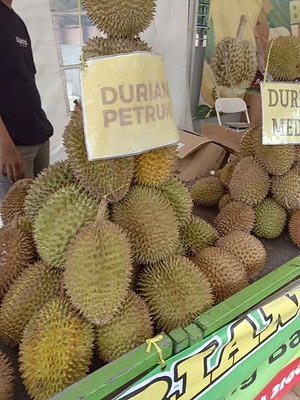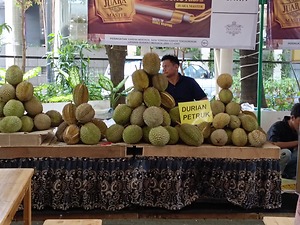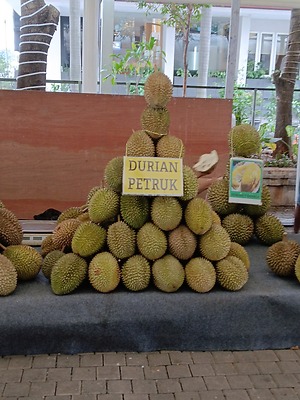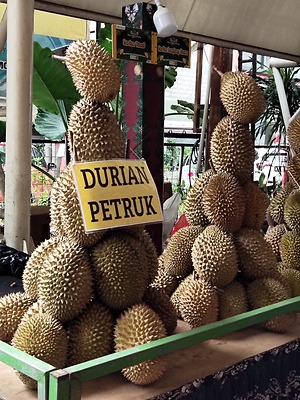


Petruk Durian
Estimated Inventory, lb : 0
Description/Taste
Petruk durians are moderately-sized, elongated fruits, typically averaging 1 to 1.5 kilograms in weight, and have a tapered, teardrop shape. The skin is entirely covered in sharp, triangular spikes and generally ranges in color from yellow, bronze, to green. Underneath the spikes, the thin skin can easily be split to reveal an ivory, spongy interior. In the center of the fruit, there is a chamber filled with roughly 5 to 10 oval, brown-black seeds surrounded by soft and creamy, yellow flesh. Petruk durians are aromatic and are highly valued for their creamy, yogurt-like consistency. The flesh has an initially sweet, tropical flavor with lemon overtones followed by a funky, acidic, and bitter finish.
Seasons/Availability
Petruk durians are available in the late winter through early spring.
Current Facts
Petruk durians, botanically classified as Durio zibethinus, are a rare variety that belongs to the Malvaceae family. The uniquely flavored cultivar is one of the most popular varieties in Java, but also one of the most difficult varieties to find. Petruk durians are highly prized for their soft texture and acidic flavor, regarded as a specialty fruit, and are sold at roadside markets, sometimes costing as much as three times the price of a regular Durian variety. While the variety is nationally recognized as a superior fruit, it is challenging to find Petruk durians due to their limited availability. It is also difficult to distinguish in local markets as some vendors sell more common varieties under the Petruk name to increase profits.
Nutritional Value
Petruk durians are a good source of vitamins A, B6, and C, and are believed to help boost the immune system and protect the body against external environmental aggressors through its antioxidant content. The fruits also provide fiber, which can help regulate digestion and contain minerals such as iron, zinc, potassium, phosphorus, calcium, and magnesium.
Applications
Petruk durians are best suited for raw applications as their pungent flavor is showcased when consumed fresh, out-of-hand. The rare variety is prized for its unique taste, and the flesh is often paired simply with complementary flavors to savor the pure flavor of the flesh. In addition to consuming the fruit as a stand-alone snack, the flesh can sometimes be blended into smoothies, drinks, and coffee, cooked with palm sugar to create a sweet, chewy treat, mixed into sauces, tossed into soups and curries, blended into ice cream, or frozen and eaten as a dessert. Petruk durians pair well with avocado, coconut, pineapple, mango, jackfruit, coffee, sugar cane, sticky rice, and condensed milk. Once opened, the flesh of the fruit should be consumed immediately or within twenty-four hours for the best flavor. If the fruit is unopened, it will keep for 1-2 weeks, depending on the degree of ripeness, when stored at room temperature.
Ethnic/Cultural Info
Petruk durians share their name with a puppet that appears in the traditional Javanese puppet theater. This style of puppetry, also known as warang, uses colorful characters to retell both fictional stories and stories associated with the Hindu religion. Petruk is often a comedic character in fictional storylines and has a long, angular nose which, to the amusement of the Javanese, is similar in appearance to the shape of the Petruk durian.
Geography/History
Petruk durians are native to Indonesia and can only be found in the town of Jepara, which is located on the island of Java. The exact origins of Petruk durians are unknown as the original “mother tree” has died, but it is believed that the variety has been cultivated for many decades and was likely a product of grafting. Today Petruk durians are challenging to find and are available through select local markets in Java.












